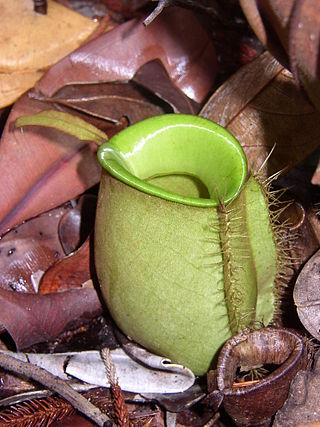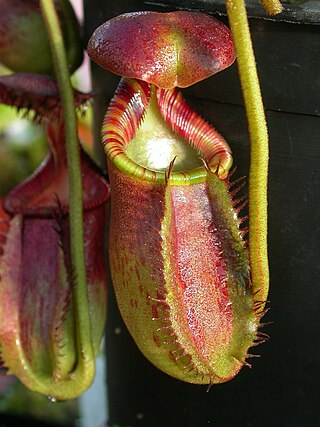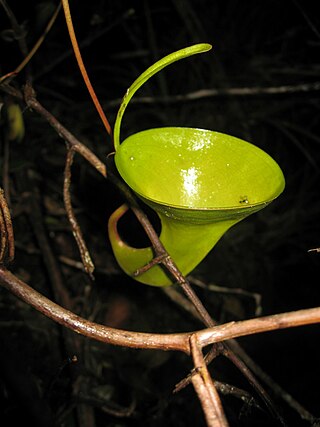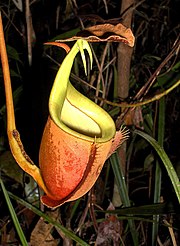
Nepenthes is a genus of carnivorous plants, also known as tropical pitcher plants, or monkey cups, in the monotypic family Nepenthaceae. The genus includes about 170 species, and numerous natural and many cultivated hybrids. They are mostly liana-forming plants of the Old World tropics, ranging from South China, Indonesia, Malaysia, and the Philippines; westward to Madagascar and the Seychelles (one); southward to Australia (four) and New Caledonia (one); and northward to India (one) and Sri Lanka (one). The greatest diversity occurs on Borneo, Sumatra, and the Philippines, with many endemic species. Many are plants of hot, humid, lowland areas, but the majority are tropical montane plants, receiving warm days but cool to cold, humid nights year round. A few are considered tropical alpine, with cool days and nights near freezing. The name "monkey cups" refers to the fact that monkeys were once thought to drink rainwater from the pitchers.

Nepenthes albomarginata is a tropical pitcher plant native to Borneo, Peninsular Malaysia, and Sumatra.

Nepenthes rajah is a carnivorous pitcher plant species of the family Nepenthaceae. It is endemic to Mount Kinabalu and neighbouring Mount Tambuyukon in Sabah, Malaysian Borneo. Nepenthes rajah grows exclusively on serpentine substrates, particularly in areas of seeping ground water where the soil is loose and permanently moist. The species has an altitudinal range of 1,500–2,650 m (4,920–8,690 ft) above sea level and is thus considered a highland or sub-alpine plant. Due to its localised distribution, N. rajah is classified as an endangered species by the IUCN and listed on CITES Appendix I.

Nepenthes rafflesiana, or Raffles' pitcher-plant, is a species of tropical pitcher plant. It has a very wide distribution covering Borneo, Sumatra, Peninsular Malaysia, and Singapore. Nepenthes rafflesiana is extremely variable, with numerous forms and varieties described. In Borneo alone, there are at least three distinct varieties. The giant form of this species produces enormous pitchers rivalling those of N. rajah in size.

Nepenthes ampullaria is a very distinctive and widespread species of tropical pitcher plant, present in Borneo, the Maluku Islands, New Guinea, Peninsular Malaysia, Singapore, Sumatra, and Thailand.

Nepenthes gracilis, or the slender pitcher-plant, is a common lowland pitcher plant that is widespread in the Sunda region. It has been recorded from Borneo, Cambodia, Peninsular Malaysia, Singapore, Sulawesi, Sumatra, and Thailand. The species has a wide altitudinal distribution of 0 to 1100 m above sea level, although most populations are found below 100 m and plants are rare above 1000 m. Despite being a widespread plant, natural hybrids between N. gracilis and other species are quite rare.

Nepenthes reinwardtiana is a tropical pitcher plant native to Borneo and Sumatra and to a number of smaller surrounding islands including Bangka, Natuna, Nias, and Siberut. Although some sources have included Peninsular Malaysia and Singapore within the range of this species, these records appear to be erroneous.

Nepenthes bicalcarata, also known as the fanged pitcher-plant, is a tropical pitcher plant endemic to northwestern Borneo, Indonesia. It is a myrmecophyte noted for its mutualistic association with a species of ant, Camponotus schmitzi. As an ant-fed plant it lacks many of the features that characterise the carnivorous syndrome in Nepenthes, including viscoelastic and highly acidic pitcher fluid, the waxy zone of the pitcher interior, and possibly even functional digestive enzymes.

Nepenthes × kinabaluensis, or the Kinabalu pitcher-plant, is the natural hybrid between N. rajah and N. villosa. It was first collected near Kambarangoh on Mount Kinabalu, Borneo by Lilian Gibbs in 1910 and later mentioned by John Muirhead Macfarlane as "Nepenthes sp." in 1914. Although Macfarlane did not formally name the plant, he noted that "[a]ll available morphological details suggest that this is a hybrid between N. villosa and N. rajah". It was finally described in 1976 by Shigeo Kurata as N. × kinabaluensis. The name was first published in Nepenthes of Mount Kinabalu, but was a nomen nudum at the time as it lacked an adequate description and information on the type specimen. The name was subsequently published validly by Kurata in 1984.

Nepenthes lowii, or Low's pitcher-plant, is a tropical pitcher plant endemic to Borneo. It is named after Hugh Low, who discovered it on Mount Kinabalu. This species is perhaps the most unusual in the genus, being characterised by its strongly constricted upper pitchers, which bear a greatly reduced peristome and a reflexed lid with numerous bristles on its lower surface.

Nepenthes stenophylla, or the narrow-leaved pitcher-plant, is a tropical pitcher plant endemic to Borneo. The species produces attractive funnel-shaped pitchers up to 25 cm high. It is listed as Least Concern on the IUCN Red List. Nepenthes stenophylla belongs to the loosely defined "N. maxima complex", which also includes, among other species, N. boschiana, N. chaniana, N. epiphytica, N. eymae, N. faizaliana, N. fusca, N. klossii, N. maxima, N. platychila, and N. vogelii.
Dr. Charles M. Clarke is an ecologist and botanist specialising in the carnivorous plant genus Nepenthes, for which he is regarded as a world authority. Clarke has an honours degree in Botany from Monash University in Melbourne, and a Ph.D. in Ecosystem management at the University of New England, in Armidale, New South Wales.

Nepenthes clipeata, or the shield-leaved pitcher-plant, is a tropical pitcher plant known only from the near-vertical granite cliff faces of Mount Kelam in West Kalimantan, Indonesia. It has an elevational distribution between approximately 600 and 800 m.

Nepenthes ephippiata, or the saddle-leaved pitcher-plant, is a tropical pitcher plant endemic to Borneo. It occurs in the Hose Mountains of central Sarawak, as well as Mount Raya and Bukit Lesung in Kalimantan. It grows in montane forest from 1,000 to 1,900 meters elevation.

Nepenthes hispida is a tropical pitcher plant species native to Borneo. It grows at elevations of 100 to 800 m in kerangas forest. It is known with certainty only from Lambir Hills National Park and surrounding areas.

Nepenthes campanulata, the bell-shaped pitcher-plant, is a tropical pitcher plant native to Borneo. It has also been reported from Palawan, the Philippines, though further field work is needed to confirm this identification.

Nepenthes mapuluensis, the Mapulu pitcher-plant, is a species of tropical pitcher plant native to East Kalimantan, Borneo. It is known only from a restricted geographical range and is listed as Endangered on the IUCN Red List.

Nepenthes inermis is a tropical pitcher plant endemic to the Indonesian island of Sumatra. The specific epithet inermis is Latin for "unarmed" and refers to the upper pitchers of this species, which are unique in that they completely lack a peristome.

Nepenthes × trichocarpa, the dainty pitcher-Plant, is a common natural hybrid involving N. ampullaria and N. gracilis. It was originally thought to be a distinct species and was described as such.

Nepenthes chaniana is a tropical pitcher plant species belonging to the genus Nepenthes. It is characterised by a dense indumentum of long, white hairs. Pitchers are cylindrical and mostly white to yellow in colouration. Nepenthes chaniana belongs to the loosely defined "N. maxima complex", which also includes, among other species, N. boschiana, N. epiphytica, N. eymae, N. faizaliana, N. fusca, N. klossii, N. maxima, N. platychila, N. stenophylla, and N. vogelii.




















